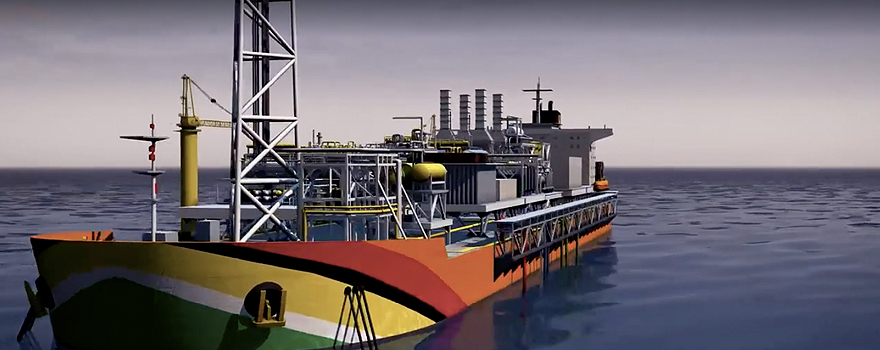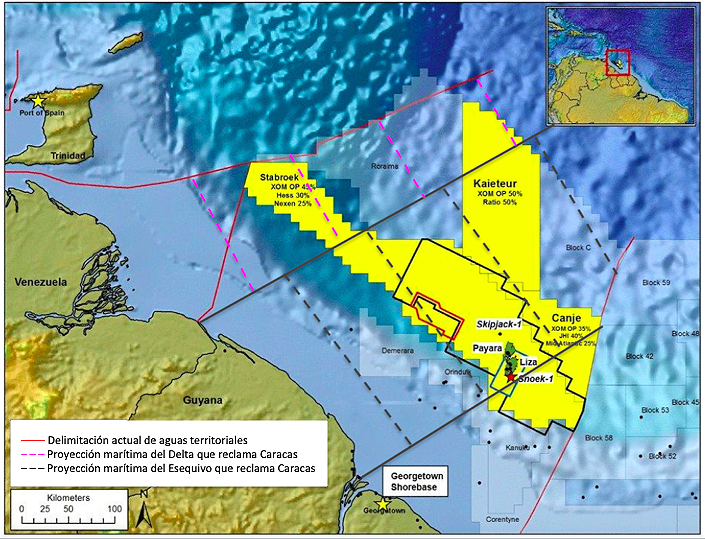One of the poorest countries in the Americas may become the world's largest oil producer per capita, disrupting the relationship with its neighbors.
Promising oil discoveries in Guyana's waters augur greater regional relevance for this small and poor South American country. Territorial disputes between Venezuela and its neighbor, on account of the Essequivo territory that Caracas has historically claimed (more than half of Guyana's surface area), may be exacerbated by the opening of wells in deep waters that Guyana administers but over which Venezuela seeks fair international arbitration.

Image created by ExxonMobil about its exploration in Guyana's waters.
article / Ignacio Urbasos Arbeloa
Guyana has found oil deposits 193 km off its coast by ExxonMobil that may completely change the course of its Economics and its international influence. After several decades of failed attempts in the search for hydrocarbons in its subsoil and an exhaustive search since 1999, in 2015 the Liza field responded positively to seismic analysis, subsequently showing abundant oil reserves at a depth of 1,900 meters offshore. At the moment estimates speak of 3.2 billion barrels of recoverable oil to be found in the Guiana Basin, which extends to Suriname, another country with a promising oil future. Companies such as Total, Repsol or Anadarko have already obtained exploration rights in the different blocks offered so far by the Guyanese government, however it is the Stabroek Block, exploited by Exxon (45%), Hess (30%) and the Chinese CNOOC (25%), which will be the first to start producing, in 2020.
With expectations of reaching 700,000 barrels per day by 2025, this is the largest global deepwater finding of the lustrum and one of the most valuable additions to conventional oil production. The crude is Pass for middle distillates, precisely what Gulf of Mexico refiners are looking for in a market saturated by light crude from fracking. agreement optimistic estimates, by 2025 this impoverished country of about 700,000 people would surpass OPEC member Ecuador in oil production, making it the world's largest producer of barrels per capita (ahead of the current leader, Kuwait, which has a production of 3.15 million barrels per day and 4.1 million inhabitants). Production costs per barrel are estimated at $26 considering taxes, so profits are expected to be abundant in practically any future scenario (currently the barrel of WTI is around $50), making Guyana one of the great attractions in the oil industry at the moment. Prospecting led by Exxon, a company that already dominates exploitation in the so-called deepwaters, had in 2018 hit fees close to 80%, which has generated enormous expectation in a sector accustomed to fees of 25%.
The positive impact this finding will have for Guyanese Economics is evident, although it is not without Exempt challenges, given the high levels of corruption or a bureaucracy and political class inexperienced for negotiations at this level. The IMF, which is advising Guyana, has already recommended freezing further negotiations until the tax system is reformed and the country's bureaucratic capacity is improved. The same agency has estimated a 28% GDP growth for Guyana by 2020, a historic figure for an Economics whose exports are based on rice, sugar cane and gold. The government is already designing an institutional framework to manage oil tax revenues and cushion their impact on other sectors. Among the proposals is the creation of a sovereign wealth fund similar to those of Norway, Qatar or the United Arab Emirates, which could become effective this year with the partnership of experts from the Commonwealth, to which the country belongs.
Historic dispute with Venezuela
These new discoveries, however, increase the tension with Venezuela, which maintains a territorial dispute over 70% of the Guyanese territory, the Guayana Esequiba belonging to the Captaincy General of Venezuela during the Spanish Empire. The disputed territory was later de facto colonized by the British Empire when the British took control over the Dutch territories of Guyana in 1814. In 1899 an international tribunal ruled unanimously in favor of the United Kingdom against Venezuelan claims. However, later revelations demonstrated the existence of serious elements of corruption in the judicial process, making the award "null and void" (non-existent) in 1962. In 1966 the United Kingdom, as representative of British Guyana, and Venezuela signed the Genevaagreement , which established the commitment to reach an agreement: the 1970 Port of Spain protocol , which froze negotiations for 12 years. After the end of this period, Venezuela demanded Guyana to return to direct negotiations, and in accordance with the Charter of the United Nations, the diplomatic formula of good offices has been agreed upon and is still in force today, but no significant progress has been made. Since Guyana's independence in 1966, Venezuela promoted an indigenous separatist movement in the region, Rupununi, which was harshly repressed by Georgetown, setting a precedent of military tension on the border.
Although a formal agreement on the territorial dispute has never been reached, the arrival of the socialist People's Progressive Party (PPP) to power in Guyana in 1992 and the electoral victory of Hugo Chávez in Venezuela in 1999 ideologically aligned both countries, which allowed them to reach unprecedented cooperationDegrees during the first decade of the 21st century. In the framework this golden era, Guyana participated between 2007 and 2015 in the Venezuelan Petrocaribe initiative, receiving some 25,000 barrels per day of oil and derivatives, which constituted 50% of its consumption, in exchange for rice valued on market price. On the other hand, Guyana supported Venezuela's candidacy to the United Nations Security committee in 2006 in exchange for an express promise by Caracas not to use the privileged position it temporarily acquired in the territorial dispute. An important precedent was Hugo Chávez's declaration in 2004 of not opposing Guyana "to unilaterally grant concessions and contracts to multinational companies, as long as this favors the development the region". In spite of the existence of unfriendly acts between the two States during this period, the vital importance that the Venezuelan anti-imperialist foreign policy gave to the Caribbean during Chávez's mandate, obliged him to treat the topic from the most absolute moderation to avoid a disagreement with CARICOM and to maintain Guyana's support in the OAS.
|

Map of Guyana's oil exploitation blocks (in yellow), with the delimitation of territorial waters and Venezuela's claims.
|
New tensions
As a result of the oil discoveries, the historic territorial dispute with Venezuela has returned to the forefront. A change of sign in the Georgetown government has also contributed to this. The 2015 elections brought to power in Guyana the A Partnership for National Unity, led by former military officer David Granger. This is a multi-ethnic coalition that could be described as center-right and with less ideological sympathies towards neighboring Venezuela than those professed by the previous president, Bharrat Jagdeo of the PPP. At the end of 2018 there was an escalation of tension, following the seizure on December 23 by the Bolivarian National Navy of two Guyanese-flagged vessels belonging to ExxonMobil that were prospecting in the area and which, agreement to the version of the Government of Nicolás Maduro, had entered Venezuelan waters. The international response was not long in coming and the United States urged Venezuela to "respect international law and the sovereignty of its neighbors". Precisely one of the most complex issues in the territorial dispute is the projection of the waters of each country. The position defended by Venezuela is to draw the maritime limits in agreement with the projection of the Orinoco River delta, as opposed to the Guyanese position which draws the line in a manner favorable to its territorial interests. Although this was a secondary element in the territorial dispute, the economic potential of these waters places them at the center of the discussion.
To all this must be added the declaration of the Lima group , of which Guyana is a member, not to recognize the May elections in Venezuela and to threaten to sanction the country economically (although, to date, it has not recognized the opposition candidate Juan Guaidó as interim president). The international ostracism of the Bolivarian Republic has allowed Guyana to obtain important diplomatic support from the aforementioned Lima group , CARICOM and the United States in relation to its international dispute and the detention of the Exxon ships.
The future of relations between Venezuela and Guyana depends to some extent on the result of the upcoming March elections in the latter country, which will pit the hitherto president, David Granger, recently ousted from power by means of a motion of no confidence, against the leader of the PPP, Bharrat Jagdeo, whose party has maintained the best relations with Chavista Venezuela. The no-confidence motion is a historic milestone for the South American country, which will have to prove its social cohesion and political stability amid geopolitical tensions and an international investment community that is watching closely the development of events.
Increased defense revenues
Georgetown, for the moment, limits itself to diplomatic action to defend its territorial sovereignty, but documents of the Guyanese Defense Forces prior to the oil discoveries already identified the need to develop military capabilities in case such resources were found in the country. agreement Exxon's estimates, Guyana would start earning US$ 16 billion annually from 2020, which would increase the military expense , currently around 1% of GDP. The Army of the Cooperative Republic of Guyana conducted in August 2018 the largest military exercises in its history, mobilizing 1,500 troops out of an Army estimated at around 7,000. available information about the material resources of navy and aviation show the need for quantitative and qualitative improvement. Overcoming the existing ethnic divisions between the population of Indian and African origin must be one of the priorities of the Armed Forces, which suffer from a clear under-representation of the original Indian community, a cause of historical mistrust by civil society.
In the final, the Caribbean region of South America will be marked in the coming years by Guyana's economic potential and its struggle for territorial survival in the face of Venezuela's legitimate demands. Achieving a real development of the oil industry will undoubtedly be the best armor for its future as a sovereign and independent country. The political uncertainty in Venezuela, immersed in an enormous crisis, generates the fear of a possible military escalation as an escape valve to the internal economic and political pressure against a rival that lacks the resources to face it. The capacity of Guyana's political class to manage the brutal increase in its economic resources after 2020 is still an unknown, but it is possible to imagine that the second poorest country in the Western Hemisphere will reach great heights of development if it is able to learn from its neighbors and manage a regional context that is favorable to its national interests.